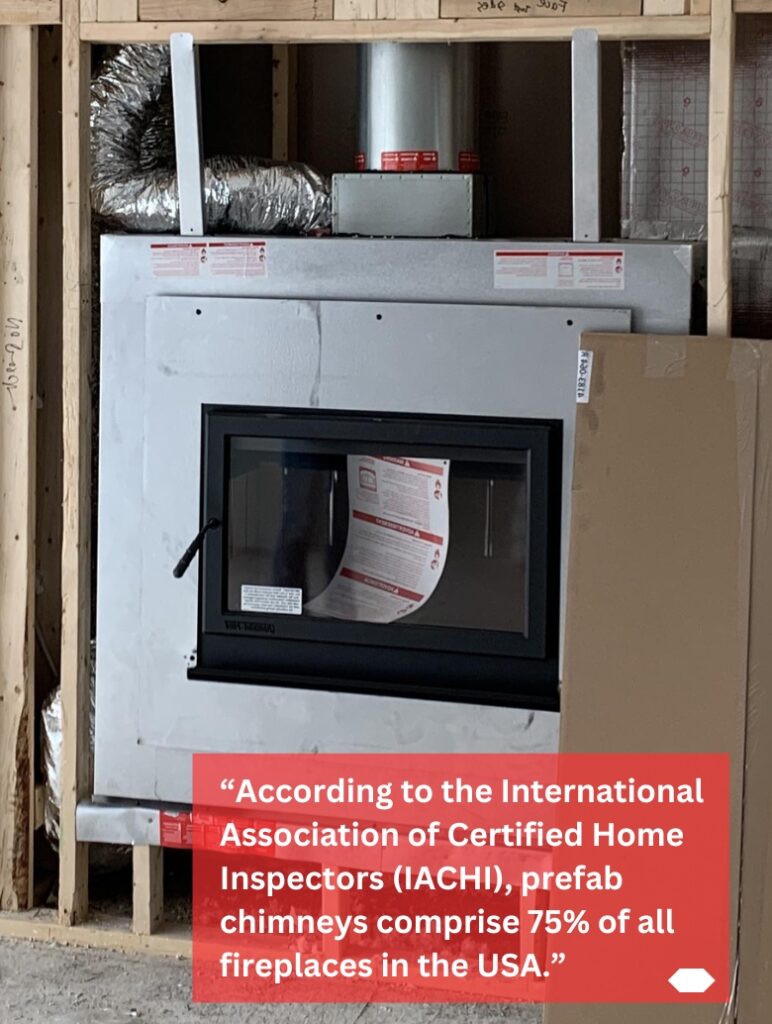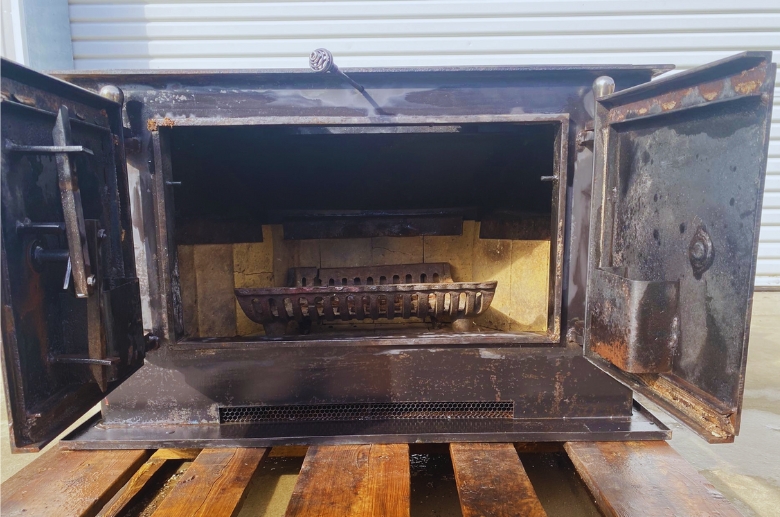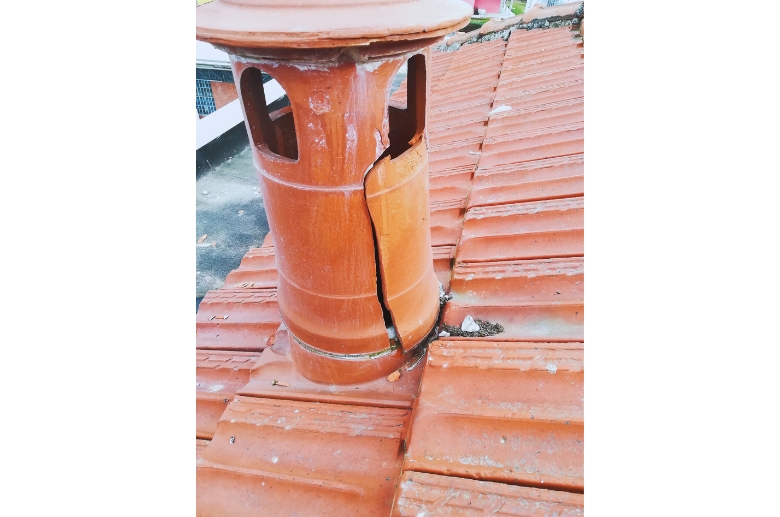Prefabricated or factory-built fireplaces have gained immense popularity among homeowners over the past decade. These fireplaces come in various models and offer a convenient and cost-effective alternative to traditional masonry fireplaces. They look great in many homes.

According to the International Association of Certified Home Inspectors (IACHI), prefab chimneys comprise 75% of all fireplaces in the USA. This type of fireplace is popular for wide design options, easier installation or construction benefits, and even easier repair compared to traditional masonry fireplaces.
But like any other fireplace, prefab fireplaces can encounter several problems. These issues, such as warping, cracking, and corrosion, can be quite concerning and even a source of danger.
If you’re thinking about getting or already have a prefabricated fireplace, you’ll want to stick around because we’re about to reveal some common prefabricated fireplace problems.
We’ll also provide valuable solutions to ensure you can maintain a cozy and fully functional heating source for your home.
——
Do You Need to Hire Chimney & Fireplace Expert?
Get free quotes from qualified experts near you. No commitment required!
——
Common Prefabricated Fireplace Problems
Let’s explore common prefabricated fireplace problems, their causes, effects, and solutions.
1. Warping and Cracking
Warping refers to the distortion or deformation of an object, typically due to uneven stress or temperature variations, causing it to change shape from its original form.
Cracking refers to forming fractures or fissures in a material or object, usually due to stress, pressure, or structural weaknesses, leading to separating its parts.
Warping and cracking can stem from several causes, but the most common culprits include:
- Exposure to extreme temperatures and sudden temperature fluctuations
- Improper installation
- Inadequate cleaning and maintenance
- Age and wear
The consequences of warping and cracking in prefabricated fireplaces can be detrimental. Severe cracks compromise the safety of your fireplace unit, as they can allow heat and fumes to leak into the surrounding walls, potentially causing a fire hazard.
They also reduce the fireplace’s efficiency, leading to heat loss and increased energy consumption. Additionally, it can negatively impact the aesthetics of your fireplace, diminishing its overall appeal and value.
How to Fix Warping and Cracking
Warping in prefabricated fireplaces can be remedied effectively through a series of targeted actions. Begin by examining the severity of the warping; if it’s a minor issue, consider using a rubber mallet to gently tap the warped component back into its original shape.
For more extensive warping, replacement might be necessary. In such cases, acquire new refractory panels or firebox walls specifically designed for your fireplace model.
Conversely, mild cracking can be managed effectively using repair mortar. This is a doable DIY task that can save you time and money. Begin by cleaning the cracked area thoroughly, removing any loose debris.
Mix the repair mortar according to the manufacturer’s instructions and apply it to the cracks using a putty knife. Ensure a smooth finish, and let it cure as per the recommended time frame.
Always follow safety guidelines and product instructions when performing these repairs.
2. Rust and Corrosion

Rust and corrosion compromise the structural integrity of your fireplace, leading to leaks, weakened components, or, in the worst cases, a complete breakdown of materials and parts. The aesthetics of your fireplace also suffer, with unsightly rust spots and discoloration marring its appearance.
That’s not all. Excessive rust and corrosion also reduce the efficiency of your fireplace, affecting its heating performance and potentially increasing energy consumption, costing you a great deal of money.
How to Fix Rust and Corrosion
While professional assistance is recommended for addressing extensive rust and corrosion issues, here are some tips for cleaning mild rust and corrosion on your prefab fireplace.
Gather Supplies:
- White vinegar
- Baking soda
- Steel wool or wire brush
- Scouring pad (for pans)
- Gloves
- Protective eyewear
Here are the steps to remove the rust and corrosion:
- Wear gloves and protective eyewear to safeguard yourself from chemicals and debris.
- Remove any loose rust or corrosion with a wire brush or steel wool.
- Submerge the rusted or corroded area in white vinegar for several hours or overnight.
- Create a paste of baking soda and water.
- Apply the paste to the affected area and let it sit for an hour.
- Apply gentle but firm pressure to avoid damaging the metal surface.
- Rinse the area thoroughly with clean water to remove any remaining vinegar or baking soda residue.
- Dry the area completely with a clean towel to prevent further rust formation.
We also advocate that you protect your fireplace from moisture by installing a rain cap or shelter to shield it from the elements.
3. Poor Installation
Proper installation is the cornerstone of a safe, efficient, and long-lasting prefabricated fireplace. A fireplace correctly installed according to the manufacturer’s instructions adheres to local building codes and safety standards, reducing the risk of fire hazards and carbon monoxide leaks.
It also maximizes heat output while minimizing energy waste. In addition, a well-installed fireplace has a longer lifespan, minimizing the need for premature repairs or replacement.
On the flip side, improper installation can result in faulty venting or inadequate clearances to combustible materials, endangering your home and loved ones. Bad installation also contributes to inefficient burning, causing wasted energy and increased heating costs.
Fixing Poor Installation
Rectifying a poorly installed prefabricated fireplace requires the intervention of a certified fireplace professional or technician with expertise in the field. Engaging their services is crucial to conducting a comprehensive evaluation of the existing installation, pinpointing issues, and implementing essential adjustments to ensure compliance with safety standards.
To address a subpar installation, the professional may need to reposition the fireplace, make alterations to the venting system, or tackle structural concerns. This proactive approach not only enhances safety but also ensures that the fireplace operates efficiently and in accordance with relevant codes.
4. Insufficient Ventilation
Inadequate ventilation in prefabricated fireplaces often results from obstructions like debris and bird nests in a chimney or pipe, hindering airflow and causing incomplete combustion.
Improperly sized chimneys also disrupt the natural draft required for ventilation, and environmental factors like strong winds can force downdrafts.
As a rule of thumb, your chimney should extend at least 3 feet above the roof, be 2 feet taller than any nearby structure within 10 feet, and be positioned at least 10 feet away from obstructions.
Following these rules helps ensure proper chimney performance and ventilation and reduces fire hazards.
Consequences of Insufficient Ventilation
Insufficient ventilation reduces heating efficiency and increases emissions, leading to fuel wastage and indoor air quality concerns. It also results in creosote buildup, elevating the risk of chimney fires.
Additionally, inadequate ventilation causes smoke and combustion gases to enter your living space, causing discomfort and health issues.
Fixing Insufficient Ventilation
To fix this prefabricated fireplace problem, start with a chimney sweep inspection to clear blockages and debris. Ensure a sufficient air supply by opening a window or installing an external air supply vent.
Also, evaluate chimney sizing and consider wind deflectors or caps to counteract downdrafts caused by strong winds.
5. Structural Issues
Structural problems can compromise the safety and effectiveness of prefabricated fireplaces. Here are the three common structural concerns:
Firebox Issues
Problems arise due to poor fireplace maintenance, temperature fluctuations, and improper installation. This results in heat exposure, leading to cracks in the firebox’s refractory panels or walls.
Chimney Problems

The main contributors to this structural problem are prolonged exposure to harsh weather conditions, moisture infiltration, and the effects of aging. If left unaddressed over an extended period, these factors can result in damaged flue liners, deteriorating crowns, or tilting chimneys.
Foundation Concerns
Foundation concerns in prefabricated fireplaces can jeopardize the fireplace’s stability and the safety of your home. Poor initial installation, from inadequate support or improper anchoring, lays the foundation for structural problems.
Due to soil shifts or seismic activity, ground movements can further exacerbate these issues. Also, settling foundations, where the fireplace’s base slowly sinks or shifts, also contribute to the structural instability of the fireplace.
How to Fix Structural Issues
To resolve the above structural issues effectively, ensure damaged refractory panels or walls are replaced with components designed for your fireplace model. Fixing or replacing flue liners, crowns, or even chimney reconstruction (for severe damage) will suffice for chimney problems.
Addressing foundation concerns and making the necessary adjustments to ensure stability will help deal with structural problems.
——
Do You Need to Hire Chimney & Fireplace Expert?
Get free quotes from qualified experts near you. No commitment required!
——
Signs of Prefabricated Fireplace Problems
Let’s explore some of the signs of prefabricated fireplace problems:
Cracks in Refractory Panels
Inspect the interior of your fireplace for cracks in the refractory panels that line it. Focus on areas where the panels meet or might be exposed to the most heat. Also, watch out for loose or crumbling pieces of refractory material, as this indicates significant deterioration.
Rust and Corrosion
Check for rust or corrosion on metal components, such as the firebox, damper, or chimney cap. Ensure you also inspect for signs of water leaks or moisture, like water stains, dampness, or visible damage to the surrounding materials.
Soot Buildup

Inspect the chimney’s interior and the walls, and pay attention to the thickness of the soot or creosote. Thin layers may not be a significant concern, but thicker accumulations can pose a fire hazard.
This is especially important when burning wood in prefab fireplaces, as these models have specific requirements and tolerances for heat and byproducts like soot and creosote. Ensuring your prefab fireplace is clean and well-maintained is crucial for safe and efficient operation, preventing potential risks associated with wood burning.
Performance Issues
Below are some performance problems that will highlight whether your fabricated fireplace has problems:
Difficulty Starting Fires
Consistently struggling to ignite a fire can indicate problems with the ignition system, fuel quality, or airflow. It also indicates malfunctioning components like the pilot light, ignition switch, and poor-quality or damp firewood.
Check the ignition system and its components to ensure they function optimally.
Smoke Coming into the Room
When smoke doesn’t draft up the chimney correctly and instead enters the room, it suggests a problem with the chimney, flue, or air supply.
This affects the safety and comfort of your home and might lead to carbon monoxide poisoning. Inspect the fireplace chimney and ensure no blockage from dirt and debris.
Low Heat Output
Inefficient combustion is the most common reason for low heat output and results from restricted airflow, a malfunctioning burner, or the use of low-quality wood. Heat distribution is another reason and is caused by problems with the blower or blocked vents.
Clean vents, flues, and dampers regularly. Check and clean the burner or heating element to ensure it functions correctly. Confirm the blower or fan is working correctly, the air filters are clean, and the vents are free from blockages.
Also, use high-quality, seasoned firewood with low moisture content to promote efficient combustion.
What Is The Life Expectancy Of A Prefab Fireplace?
Unlike a masonry fireplace that lasts up to 100 years, a well-maintained prefab fireplace can last anywhere from 20 to 30 years. However, this timeframe can vary significantly based on several key factors. They include the following:
- Quality of Materials: High-quality, heat-resistant components have a longer lifespan than cheaper alternatives.
- Maintenance and Care: Regular cleaning, inspections, and maintenance can extend the life of your prefab fireplace. Neglecting these tasks can lead to premature wear and deterioration.
- Frequency of Use: The more frequently you use your fireplace, the faster it may wear out. Excessive use can result in faster degradation of components like refractory panels or dampers.
- Environmental Conditions: Environmental factors, such as exposure to extreme weather, moisture, or corrosive substances, can impact the longevity of your fireplace. Proper protection and maintenance can mitigate these effects.
Conclusion
Prefabricated fireplaces offer comfort and ambiance to your home but are not immune to common problems. Warping, rust, poor installation, insufficient ventilation, structural concerns, soot buildup, and performance issues can affect your fireplace’s safety, efficiency, and lifespan.
Adhere to proper maintenance and regular inspections to address fireplace problems early on. Also, seek professional assistance for advice before attempting to fix these problems.
Hiring an expert guarantees you a well-done job and peace of mind. Contact us today to schedule an appointment for any prefabricated fireplace problems.






